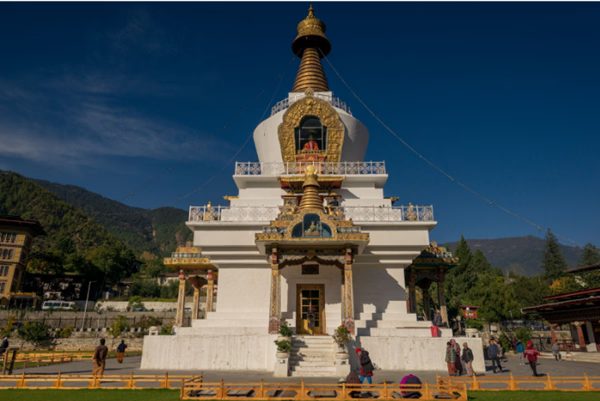The National Memorial Chorten is one of the most iconic structures in Thimphu, Bhutan. This pristine white stupa, adorned with gleaming golden spires, was constructed in 1974 to honour the third king of Bhutan, His Majesty Jigme Dorji Wangchuck, known as the Father of Modern Bhutan. Located on Doeboom Lam near Thimphu’s main roundabout and the Indian military hospital, it is a prominent symbol of Bhutanese culture and spirituality.

Historical Significance
The idea for the chorten was conceived by Thinley Norbu Rinpoche, a revered figure in the Nyingma tradition of Tibetan Buddhism. Commissioned by the king’s mother, Phuntsho Choden, the chorten was built after King Jigme Dorji Wangchuck’s passing in 1972. His vision of creating “a chorten to represent the mind of Buddha” was realised through this remarkable structure.
Unique Features of the Chorten
Unlike many stupas that enshrine relics, the National Memorial Chorten features a portrait of the king in ceremonial attire. The structure is a Tibetan-style Jangchup Chorten with a unique vase-like design, flaring outward instead of forming a dome. The stupa is crowned by a crescent moon and sun and decorated with intricate depictions of wrathful deities in Yab-Yum poses.
Architectural Details
Approaching the chorten through a tranquil garden, visitors encounter an ornate gate with carvings of Avalokiteshvara (compassion), Manjushri (wisdom), and Vajrapani (power). Inside, the walls are engraved with images of Ngawang Namgyal, Gautama Buddha, and Padmasambhava, alongside large prayer wheels.
Spiritual Significance and Interior Design
The interior is a treasure trove of Buddhist teachings. The ground floor is dedicated to Vajrakilya teachings with four shrines, each displaying images of the king and a central Buddha statue. A staircase leads to two additional floors, dedicated to the Drukpa Lineage and Lama Gongdu teachings. The top floor showcases paintings of Nyingma deities and bardo visions, with a gallery offering panoramic views of Thimphu.
Daily Devotion and Cultural Importance
The chorten is a daily hub for devotion, attracting elderly Bhutanese who circumambulate the structure, spin prayer wheels, and offer prayers. The annual Moenlam Prayer Festival, led by the Je Khenpo, enhances its spiritual importance.
Why Visit the National Memorial Chorten?
A visit to the National Memorial Chorten provides a deep dive into Bhutan’s rich spiritual and cultural heritage. From its unique architecture to its profound religious significance, it is a must-visit site in Thimphu.

Plan Your Bhutan Journey
Ready to explore Bhutan’s wonders? Let us help you plan your perfect Bhutan adventure, Contact us today for a personalised travel experience through the Land of the Thunder Dragon.
Popular Bhutan Tour Packages